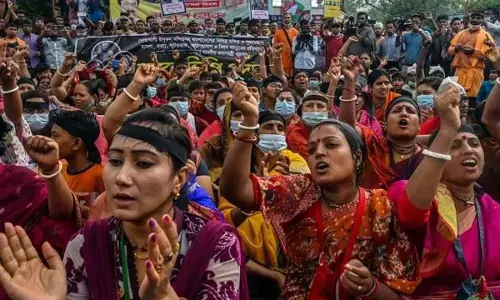Wind energy leader faces headwinds

India’s overall potential for wind farm repowering is 25.4 GW, with Tamil Nadu alone contributing 7.3 GW. Leveraging this repowering potential is critical for optimising wind energy production, making it a key element in the state’s clean energy transition
Wind power makes up nearly 30% of TN’s total installed power capacity
Chennai: Despite being a frontrunner in India’s wind energy sector, Tamil Nadu faces serious challenges in maximising its wind energy capacity. And ironically, one of the key obstacles and challenges has been thrown up by its own wind energy repowering policy – says a new report from New Delhi-based think tank, Centre for Science and Environment (CSE).
Says Nivit K Yadav, programme director of CSE’s industry and renewable energy teams: “Wind power makes up nearly 30 per cent of Tamil Nadu’s total installed power capacity. But the state struggles with its outdated turbines, that have significantly reduced the contribution of wind energy to just 15 per cent of the state’s power generation. To add to this, the shortfalls and limitations of Tamil Nadu’s wind energy repowering policy have stopped the state from achieving its true potential.”
The report – titled Accelerating Wind Repowering in Tamil Nadu – was released at a workshop. Says Binit Das, programme manager, renewable energy, CSE: “Repowering means replacing Tamil Nadu’s aging turbines with more advanced, efficient models. This could potentially triple the state’s capacity utilisation factor (CUF), improving energy efficiency and addressing ongoing safety hazards and breakdowns. Our report has analysed the potential for wind repowering in the state and critically examines the state’s recent repowering policy. It offers valuable insights and recommendations to strengthen the policy framework, paving the way for Tamil Nadu to maximise its wind energy capacity.”
The report points out that India’s overall potential for wind farm repowering is 25.4 GW, with Tamil Nadu alone contributing 7.3 GW. Says Yadav: “Leveraging this repowering potential is critical for optimising wind energy production, making it a key element in the state’s clean energy transition.”
Key limitations of the policy
Infrastructural challenge: The current policy does not encourage developers to upgrade their aging turbines due to the significant infrastructural gaps in handling the increased electricity output post-repowering. Wind energy is the backbone of Tamil Nadu’s renewable power, with a capacity of 10.7 GW as of June 2024. Repowering projects have the potential to add 7.3 GW, which could result in a three-fold increase in power generation. This brings up important concerns about the market’s capacity to absorb surplus power and the grid’s readiness to handle it.
Inadequate power evacuation infrastructure: The policy fails to address the need for improved power evacuation infrastructure, particularly upgrading the 11-kV lines, which are insufficient for repowered turbines and are unstable and frequently disrupted. There is an urgent need to upgrade these networks to at least 33 kV for efficient electricity evacuation from repowered turbines.
Additional costs for developers: Despite paying a significant infrastructure development charge of Rs 30 lakh per MW, developers still face additional costs for upgrading substations and arranging alternative power evacuation. Tamil Nadu has also imposed a resource charge of Rs 50 lakh per MW on Central Transmission Utility (CTU) wind projects, making it less attractive for developers to connect to the central grid, pushing them toward the state grid instead. Restrictive wind banking provisions: The policy limits wind banking to monthly banking for new projects and restricts usage to non-peak hours – it makes it difficult to understand what developers will do with the excess generation post-repowering during peak season.
Fragmented ownership: Fragmented ownership of wind turbines has been a significant barrier in previous repowering efforts -- the current policy lacks adequate measures to address this. With numerous private players each owning a small number of windmills, consolidating land and turbines for repowering becomes increasingly complex. This fragmented ownership hinders the ability to optimise land use and upgrade to more efficient turbines, posing a critical challenge for the successful implementation of repowering initiatives.
CSE’s economic analysis reveals that repowering wind farms in Tamil Nadu would require an additional Rs 6,336 crore to bridge the cost gap between repowering and new greenfield projects. Yadav points out that this investment is critical for making repowering economically viable.
The CSE report has proposed some measures to improve the state’s repowering policy: Upgrade power evacuation infrastructure: Immediate upgrades of 11 kV lines to at least 33 kV; Allow green energy open access: Ensuring timely payment and financial incentives through policies like Green Energy Open Access can enhance project viability; Introduce land swapping programme and collective ownership models: To address the challenge of fragmented ownership, allowing smaller turbines to be replaced with more efficient, larger models. CSE urges the Tamil Nadu government to take decisive action in addressing the identified challenges and adopting our recommendations. A robust repowering policy framework is vital for unlocking the state’s vast wind energy potential, promoting economic growth, and positioning Tamil Nadu as a leader in India’s clean energy transition.”

















